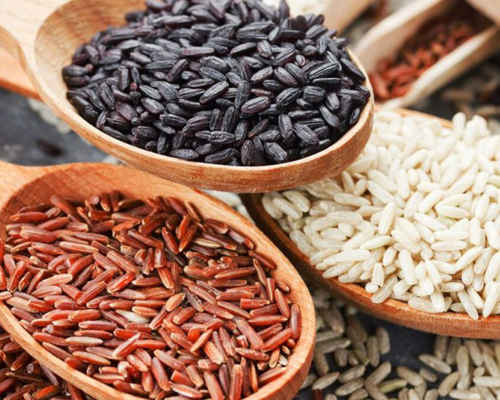Rice is undoubtedly a staple food in the Philippines. You only need to look at restaurants offering “unli-rice” (all-you-can-eat rice to go with your meal) to see just how rice-crazy we are as a people. A meal seems incomplete without the grain, whether it’s breakfast, lunch, dinner, and even merienda—some of our sweet treats, like biko and suman, are also made with rice.
Given the amount of it we eat, it makes sense to choose the healthiest possible rice to include in our diet. While white is the go-to variety, the white rice nutritional value comes in last when compared to other types. So, it’s time to consider other varieties of rice: brown, black, and red.
The Problem with White Rice
Many people prefer white rice because of its flavor and texture. But, as with other white foods like bread and pasta, white rice is more processed than the other types. During the refining process, it’s stripped of its bran, germ, and husk to reveal the white, smooth grain we’re all familiar with.
However, this process also strips white rice of most of its nutrients, which are mainly found in the parts that are discarded. Rinsing the rice before cooking may further degrade its nutrient content. And because white rice doesn’t have any bran, it also has significantly less fiber, which means two things: 1) It has a higher glycemic index than other types of rice, thereby causing a greater spike in blood sugar and making it less ideal for those with diabetes; and 2) you get hungrier sooner, which may lead to overeating and weight gain over time.
Rice and Shine!
You can get greater health benefits by switching to other types of rice:
Brown rice. Brown rice has a chewier texture and a nuttier flavor because it retains some of the outer layers. It’s minimally processed, with the bran and the germ layers remaining intact. It thus retains its fiber content as well as most of the vitamins and minerals: thiamine, which is good for your nervous system, muscles, and heart, among other organs; iron, which helps eliminate fatigue; calcium, which helps keep bones strong; magnesium, which can keep your stress levels in check; and potassium, which is good for heart health.
The calories in brown rice aren’t drastically different from those in white rice and neither is the carbohydrate content. But brown rice does have more protein than white rice, which, together with its fiber content, makes you feel full for longer.
Black rice. This type of rice is also known as purple rice or forbidden rice, as it’s said to have been forbidden for non-royalty in ancient China. Black rice gets its distinctive deep color from phytochemicals in the bran.
Black rice is antioxidant-rich, meaning it can help fight off free radicals that can cause damage to cells, which in turn leads to chronic diseases. In a report at the 240th National Meeting of the American Chemical Society, Louisiana State University associate professor Zhimin Xu said, “Just a spoonful of black rice bran contains more health promoting anthocyanin antioxidants than are found in a spoonful of blueberries, but with less sugar and more fiber and Vitamin E antioxidants.”
Like brown rice, the nutty, earthy black rice also has more fiber and more protein than white rice and has a lower glycemic index.
Red rice. Like black rice, red rice gets its color from anthocyanins. Research suggests that among the different types of rice, red rice has the highest level of the antioxidant—10 times more than brown rice—and may thus aid in the prevention or management of such illnesses as heart disease, diabetes, and even cancer.
The bottom line? Black and red rice seem to contain more antioxidants than brown rice, but all three varieties are nutritionally better than white rice. If you’re not a fan of the flavor and texture of brown, black, and red rice, then you can ease yourself into it. Mix a bit of your chosen variety into white rice, then gradually increase the amount of the other variety as the days go by until you’ve eliminated white rice.
sources:
https://www.huffpost.com/entry/make-the-switch-why-brown_b_8304558
https://www.healthline.com/nutrition/healthiest-rice
https://www.huffingtonpost.com.au/2016/04/29/types-of-rice_n_9802746.html





